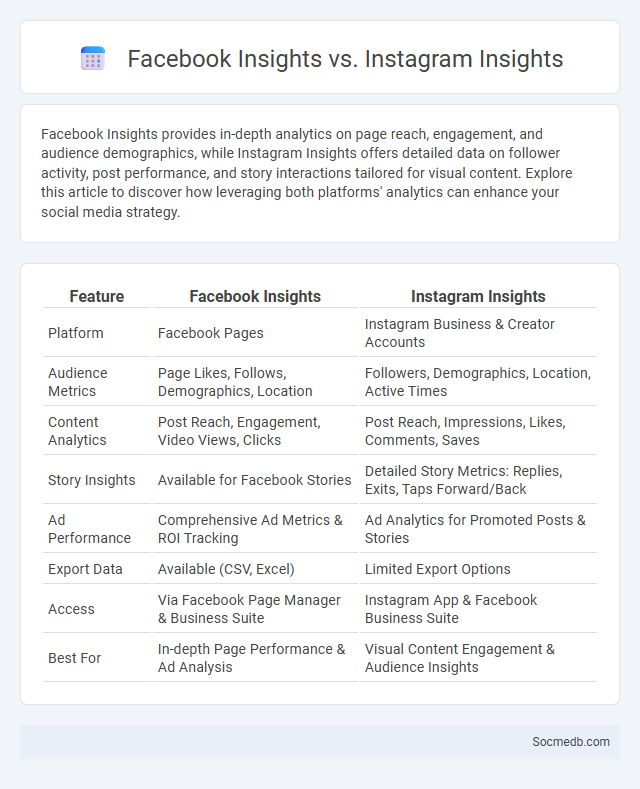
Photo illustration: Facebook Insights vs Instagram Insights
Facebook Insights provides in-depth analytics on page reach, engagement, and audience demographics, while Instagram Insights offers detailed data on follower activity, post performance, and story interactions tailored for visual content. Explore this article to discover how leveraging both platforms' analytics can enhance your social media strategy.
Table of Comparison
| Feature | Facebook Insights | Instagram Insights |
|---|---|---|
| Platform | Facebook Pages | Instagram Business & Creator Accounts |
| Audience Metrics | Page Likes, Follows, Demographics, Location | Followers, Demographics, Location, Active Times |
| Content Analytics | Post Reach, Engagement, Video Views, Clicks | Post Reach, Impressions, Likes, Comments, Saves |
| Story Insights | Available for Facebook Stories | Detailed Story Metrics: Replies, Exits, Taps Forward/Back |
| Ad Performance | Comprehensive Ad Metrics & ROI Tracking | Ad Analytics for Promoted Posts & Stories |
| Export Data | Available (CSV, Excel) | Limited Export Options |
| Access | Via Facebook Page Manager & Business Suite | Instagram App & Facebook Business Suite |
| Best For | In-depth Page Performance & Ad Analysis | Visual Content Engagement & Audience Insights |
Introduction to Social Media Insights
Social media insights analyze user behavior, engagement patterns, and content performance across platforms to inform marketing strategies. Tools like Facebook Analytics, Twitter Analytics, and Instagram Insights provide real-time data on audience demographics, reach, and sentiment trends. Leveraging these metrics enables brands to optimize campaigns, enhance user interaction, and drive targeted growth.
Overview of Facebook Insights
Facebook Insights provides detailed analytics about your page's performance, including user engagement, reach, and demographic data. You can track metrics such as page likes, post reach, and interaction rates to optimize your content strategy effectively. Using these insights helps you tailor posts to your audience's preferences and improve overall social media outcomes.
Overview of Instagram Insights
Instagram Insights provides detailed analytics about your account's performance, including data on follower demographics, engagement rates, and content reach. This tool helps you track metrics such as impressions, profile visits, website clicks, and story interactions, enabling you to understand which posts resonate most with your audience. Using these insights, you can tailor your social media strategy to boost engagement and grow your presence effectively.
What Are General "Insights" in Social Media?
General insights in social media refer to the data and analytics that reveal patterns in user behavior, engagement rates, and content performance across platforms like Facebook, Instagram, and Twitter. These insights help you understand audience demographics, peak activity times, and trending topics, enabling targeted content strategies. By analyzing metrics such as likes, shares, comments, and follower growth, businesses can optimize their social media presence for better reach and conversion.
Key Metric Differences: Facebook vs Instagram vs Generic Insights
Facebook's key metrics emphasize user engagement through likes, shares, and detailed demographic analytics, offering robust tools for audience targeting and ad performance measurement. Instagram prioritizes visual content interaction metrics such as impressions, reach, story views, and saved posts, which highlight user behavior around images and videos. Your social media strategy benefits from understanding these distinctions, enabling optimized content creation and precise audience engagement tracking across platforms.
Audience Analytics Comparison
Audience analytics tools for social media platforms such as Facebook Insights, Twitter Analytics, and Instagram Insights provide vital metrics including engagement rates, demographic breakdowns, and content performance. Comparative analysis reveals that Instagram excels in younger demographics with higher visual content interaction, while Facebook offers broader reach across diverse age groups and detailed ad targeting options. Twitter analytics emphasizes real-time engagement and trending topics, making it ideal for monitoring brand sentiment and quick response strategies.
Content Performance Tracking: Platform Variations
Content performance tracking varies significantly across social media platforms, with tools like Instagram Insights, Facebook Analytics, and Twitter Analytics offering unique metrics tailored to their user engagement patterns. Understanding these platform-specific analytics enables you to optimize your content strategy by identifying which posts resonate most with your audience and adjusting your approach accordingly. Accurate performance tracking ensures you maximize reach, engagement, and conversion rates tailored to each social media environment.
Engagement Analysis Across Platforms
Engagement analysis across social media platforms reveals key insights into user interactions such as likes, comments, shares, and click-through rates. Platforms like Instagram, Facebook, Twitter, and TikTok each exhibit distinct engagement patterns influenced by content type, posting frequency, and audience demographics. Leveraging analytics tools like Sprout Social or Hootsuite enables marketers to optimize content strategies, enhance audience targeting, and improve overall social media ROI.
Choosing the Right Insights Tool for Your Strategy
Selecting the right insights tool is crucial for optimizing your social media strategy, as it provides accurate data on user engagement, demographics, and content performance. Platforms like Hootsuite Analytics and Sprout Social offer comprehensive dashboards that help you track key metrics, enabling data-driven decisions to enhance your campaigns. Ensuring the tool integrates seamlessly with your existing systems will maximize efficiency and provide relevant, actionable insights tailored to your goals.
Final Thoughts: Maximizing Social Media Insights
Maximizing social media insights requires leveraging advanced analytics tools to track engagement metrics, audience demographics, and content performance. Brands should harness real-time data to refine marketing strategies and boost ROI by targeting high-value user segments. Continuous monitoring and adapting to emerging platform trends ensures sustained competitive advantage in the digital landscape.
 socmedb.com
socmedb.com